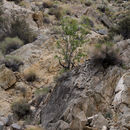en
names in breadcrumbs


Die Einblättrige Esche (Fraxinus anomala) ist ein Strauch oder Laubbaum aus den Vereinigten Staaten.
Die Einblättrige Esche ist ein Strauch oder kleiner, rundkroniger Laubbaum, der eine Höhe von 8 Metern erreichen kann. Die Zweige sind scharf vierkantig, die Endknospen sind bräunlich behaart. Die Blätter sind oft einfach, selten sind einzelne Blätter zusammengesetzt aus drei bis fünf Blättchen. Die Blättchen sind breit eiförmig bis fast kreisrund, 2 bis 5 Zentimeter lang, abgerundet oder kurz zugespitzt mit breit keilförmiger Basis. Der Blattrand ist ganzrandig oder undeutlich gekerbt. Der Blattstiel ist anfangs behaart. Die Blüten sind zwittrig oder eingeschlechtlich und stehen in kurzen, behaarten, seitenständigen Rispen. Kronblätter fehlen. Die Blüten erscheinen zusammen mit den Blättern im Mai. Als Früchte werden 2 Zentimeter lange, flache Nussfrüchte gebildet, deren Flügelsaum bis zur Basis herabläuft.[1]
Das Verbreitungsgebiet der Einblättrigen Esche erstreckt sich von den Rocky Mountains über den Südwesten der Vereinigten Staaten bis nach Kalifornien. Dort findet man sie in Auen und Ufergehölzen auf mäßig trockenen bis frischen, schwach sauren bis stark alkalischen, sandigen, kiesigen oder lehmigen, sehr nährstoffreichen Böden an sonnigen Standorten. Sie ist mäßig frosthart, verträgt jedoch Hitze.[1]
Die Einblättrige Esche (Fraxinus anomala) ist eine Art aus der Gattung der Eschen (Fraxinus). Dort wird sie der Sektion Dipetalae zugeordnet.[2]
Man kann zwei Varietäten unterscheiden:[3]
Die Einblättrige Esche (Fraxinus anomala) ist ein Strauch oder Laubbaum aus den Vereinigten Staaten.
Fraxinus anomala is a species of ash tree known by the common name single-leaf ash. It is native to the southwestern United States and northern Mexico, where it grows in a number of habitats including desert scrub and chaparral. It is unusual in the genus in that some (though not all) specimens have simple leaves instead of the pinnate leaves more characteristic of the group.
Fraxinus anomala is a deciduous shrub or small tree approaching maximum heights of five to six meters. The leaf may be simple or it may be compound, composed of up to five leaflets which look like individual leaves. Each leaflet is oval-shaped to round and may have teeth along the edges. The nondescript brownish flowers lack petals. The fruit is a flat samara up to two centimeters long and one wide, green when young and tan to brown when mature. The samaras hang in bunches.
In Arizona, singleleaf ash is found along the Arizona transition zone of the Mogollon Rim. In northern Arizona's Grand Canyon, the range extends down the main canyons from southern and southeastern Utah, its major range area, where the Canyon Lands also show the range entering upper reaches of river basins flowing from western Colorado – Colorado and Dolores Rivers; also the shorter Yellowjacket and McElmo Rivers in Colorado's extreme southwest.[1] In the Mojave Desert of California it is found in the sky island chaparral and woodland habitats. Minor locales also occur in southern Nevada and southern Wyoming.[1][2]
Fraxinus anomala is a species of ash tree known by the common name single-leaf ash. It is native to the southwestern United States and northern Mexico, where it grows in a number of habitats including desert scrub and chaparral. It is unusual in the genus in that some (though not all) specimens have simple leaves instead of the pinnate leaves more characteristic of the group.
Fraxinus anomala Torr. ex S.Wats. es una especie de árbol de la familia Oleaceae.
Es nativo de la zona suroeste de Colorado, Nuevo México en Estados Unidos y el norte de México, donde crece en un amplio número de hábitats incluidos desierto de matorral y chaparral.
Es un arbusto o árbol pequeño, caducifolio que alcanza la máxima altura de cinco a seis metros. Las hojas pueden ser simples o puede ser complejas, compuestas por un máximo de cinco alas que parecen hojas individuales. Cada ala es de forma ovalada a redonda, y pueden tener dientes a lo largo de los bordes. El fruto es una sámara plana de hasta dos centímetros de largo y uno de ancho, verde cuando joven y marrón cuando madura. Las sámaras cuelgan en racimos.
Fraxinus anomala fue descrita por Torr. ex S.Wats. y publicado en United States Geological Expolration (sic) of the Fortieth Parallel. Vol. 5, Botany 283. 1871.[1]
Ver: Fraxinus
anomala: epíteto latíno que significa "anómala".[2]
Fraxinus anomala Torr. ex S.Wats. es una especie de árbol de la familia Oleaceae.